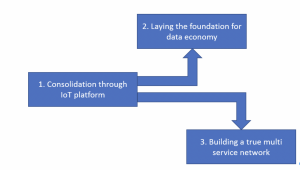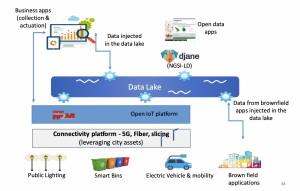Blog: Future-proof smart cities: the case of Bordeaux
By: Christophe Colinet, Smart City Program Manager, Bordeaux-Métropole and Omar Elloumi, Chair, Smart Cities Working Group, AIOTI
Bordeaux-Métropole (greater Bordeaux) set its ambitions high: it aims to be a state-of-the-art smart city and community with citizens at the centre of its digital transformation ambitions. Bordeaux has been on a smart city journey which many other cities worldwide can draw inspiration from.
It all started in early 2017, when Bordeaux profited from public funding to experiment smart lighting in a district hosting convention centres and sports stadiums. Smart lampposts delivered significant energy and cost savings thanks to the Internet of Things (IoT) model allowing to switch-on the lights when sensors detect pedestrians or other road traffic passing by or when major events are taking place.
But when investigating how IoT applications could support other city operations, Bordeaux found that the technologies required would often rely on different connectivity and data models.
It became clear that deploying IoT in silos (e.g. lighting, mobility, waste management) would limit the ability to scale smart city solutions. It also became clear that IoT platforms based on open standards are best capable of supporting a diverse range of IoT applications, the sharing of associated data (subject to proper permissions) and avoid lock-in to technology providers.
A report from Machina Research[1] identifies three routes a smart city journey could take.
- The ‘anchor route’ would see a city focusing on information and communication technology (ICT) applications to address pressing needs in vertical markets such as transportation or waste management.
- Cities taking the ‘beta route’ aim to learn from experience. They would experiment with ICT applications in reference zones before defining a precise plan for operationalising these applications at scale. This approach prizes agility, accounting for the evolution of technologies and business models.
- The ‘platform route’ looks at the requirements of envisioned ICT use cases and deploys infrastructure capable of meeting these requirements, with a view to supporting future applications.
The smart city journey of Bordeaux is best described as an iterative sequence of these three routes, beginning with the beta route and moving towards the platform route to integrate data from legacy anchor applications and build new ones.
The platform route is emerging as the dominant long-term approach for Bordeaux, and the same can be said of many other cities around the world. Bordeaux’s experience could form a valuable point of reference for other cities considering the platform route, widely considered the most adequate approach towards scaling and overall commercial viability.
City as a platform, step-by-step

Figure 1: Bordeaux ‘city as a platform’ path
Bordeaux ‘city as a platform’ path could be described as a three-step, non-sequential approach, as depicted in Figure 1.
- Consolidation through IoT platform: The city started with deployment of an IoT platform based on an open standard (namely oneM2M, that is also adopted at the international level by ITU) to support all new ICT applications. There are considerable advantages to this approach when it comes to the ownership of city data and the responsible management of citizen data in line with Europe’s General Data Protection Regulation (GDPR). It enables the reuse of data beyond originally intended purposes and assists in avoiding vendor lock-in, moving away from data silos and laying the foundation for new cross-domain ICT applications. For example, applications such as ones belonging to Mobility as a Service (MaaS) domain that are considered by Bordeaux, bring challenging cross-domain[2] requirements that could only be realised, in a cost optimised manner, through an IoT platform.
- Laying the foundation for data economy: As a next step, Bordeaux is creating the conditions necessary for the growth of a data economy with the establishment of a data lake and an associated data governance strategy. These conditions would lead to the storage of fresh as well as historical anonymized data that could be reused by different city departments or ICT application developers.
- Building a true multi-service network: If a city is to manage its own data (or responsibly manage citizen data), data collection must rely a city-managed network, without the city necessarily being the owner of the network. Multi-service networks will also encourage smart city innovation by increasing the speed and cost-efficiency with which new ICT services could be introduced.
Bordeaux sees its multi-service network as a combination of fibre and 5G, a combination to realize the 5G vision of enhanced mobile broadband; massive-scale Internet of Things; and ultra-reliable and low latency communications for sectors such as healthcare or mobility.
Emerging business models speak in favour of next-generation infrastructure ‘as a service’, where actors such as utilities, network operators and city administrations could enter joint ventures to share infrastructure investment and the benefits to result from this investment. At a technical level, this would be materialised through the provisioning of network slices that could be reused by the different venture stakeholders (including the city).
Smart Cities have the potential to play an instrumental role in expediting the deployment of 5G. City infrastructure such as multipurpose lampposts, for instance, could provide valuable support to the deployment of 5G equipment, especially where high densities of 5G equipment are required.
The Bordeaux Smart City Blueprint

Figure 2: Bordeaux Smart City Blueprint
Notes:
- NGSI-LD: An ETSI specification aiming at providing a standards-based Application Programming Interface (API) for the exchange of data between any data producer and consumer. It provides a single API for application developers to make use of city data and could enable application portability among cities implementing NGSI-LD. In this figure djane.io is an open-source implementation of NGSI-LD. The NGSI-LD API is domain neutral. It needs to be instantiated with an ontology to describe domain specific datasets (e.g. lampposts) and that’s the role the SAREF ontology -and its further specialisations- play. NGSI-LD is being piloted by Bordeaux under funding from H2020 SynchroniCity and in accordance with OASC Minimal Interoperability Mechanisms (aka MIM).
- Connectivity platform: While still under study, the aim is to leverage the city infrastructure and other assets such as fibre to consolidate connectivity mechanisms. Bordeaux is considering infrastructure partnerships using a neutral host model[3], where the city would help to build a 5G network in exchange for network slices to support smart city applications.
Footnotes:
[1] https://machinaresearch.com/news/machina-researchs-smart-city-playbook-examines-the-strategies-of-22-cities-as-they-become-smart-safe-and-sustainable/
[2] Including energy, transportation, city, insurance, car manufacturers, etc.
[3] For more information about the neutral host 5G model: https://www.luxturrim5g.com/
